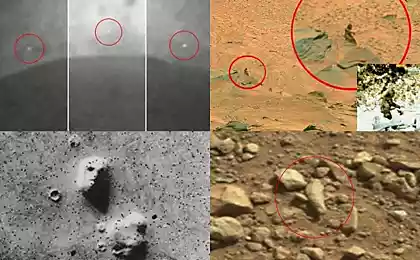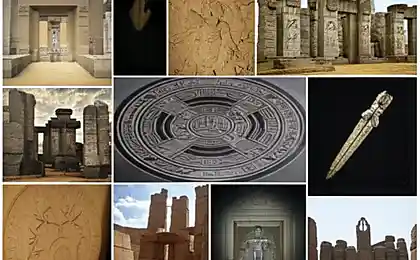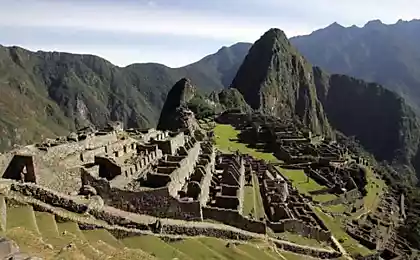3322
Mysterious objects
Fly in space, a race to build a skyscraper, clone living organisms and do many things that until recently seemed impossible. And yet still unable to unravel the mysteries of the builders and thinkers who lived thousands of years ago. Ancient cobblestone weighing hundreds of tons of surprises us more than a computer the size of half a palm.
1. Arch, Russia, Chelyabinsk region
The settlement of the Bronze Age (III-II millennium BC) is on the same latitude as Stonehenge. Coincidence? Scientists do not know. Two rows of circular wall (diameter far - 170 m), the system of drains and sewerage, well in every house - a highly developed culture of evidence. The monument was discovered by students and pupils of the archaeological expedition in 1987. (In the photo - model-reconstruction.)
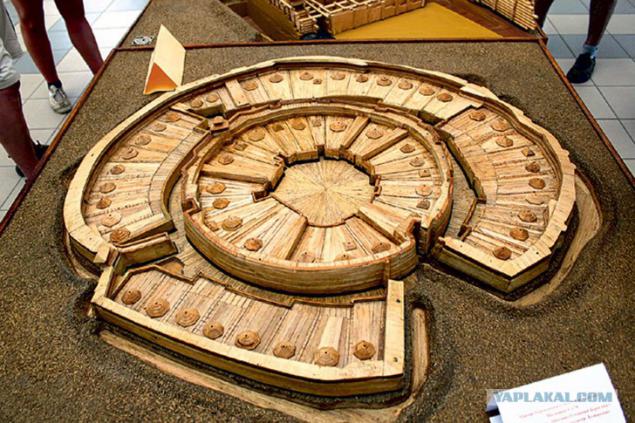
2. El Castillo, Chichen Itza, Mexico Chichen Itza
Each year during the spring and autumn equinox at the foot of the sanctuary of the supreme deity of the Maya - Feathered Serpent - gather thousands of tourists. They watch the miracle of "phenomena" Kukulcan serpent moves down along the balustrade of the main staircase. Creates the illusion of the game triangular shadows cast by nine platforms pyramid at the moment when the sun tending to decline, for 10 minutes highlights its northwest corner. Be the sanctuary shifted even a degree or anything like that would not happen
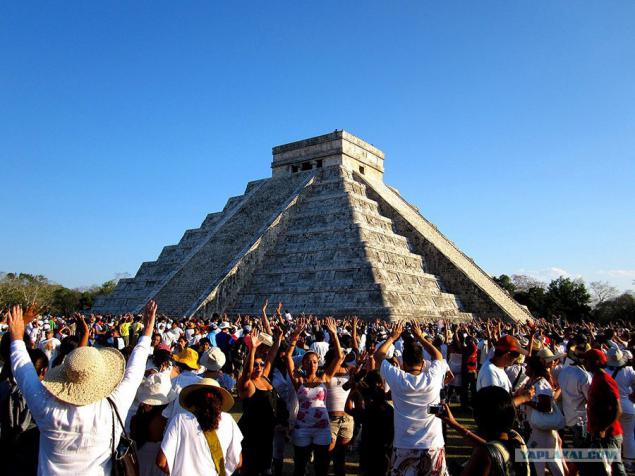
3. The Carnac Stones, France, Brittany, Carnac
In total, about 4,000 megaliths up to four meters apart slender alleys near the town of Carnac. The rows are parallel to each other or fan out, here and there form a circle. The complex dates back to the V-IV millennium BC In Brittany legends that this Merlin made petrify ranks of Roman legionaries.

4. Stone Balls, Costa Rica
Pre-Columbian artifacts, scattered near the Pacific coast of Costa Rica, were discovered in the 1930s, banana workers. Hoping to find gold inside, vandals destroyed a lot of balls. Now most of the remaining are kept in museums. The diameter of some stones reaches 2, 5 meters, weight - 15 tons. Purpose is unknown.

5. The Georgia Guidestones, United States, Georgia, Elbert
In 1979, one under the pseudonym RC Christian ordered the construction company manufacturing and installation of the monument - the construction of six granite monoliths weighing over 100 tons. On the four side plates engraved the Ten Commandments descendants in eight languages, including Russian. The last paragraph reads: "Do not be a cancer to the earth, nature, too, leave the place!»
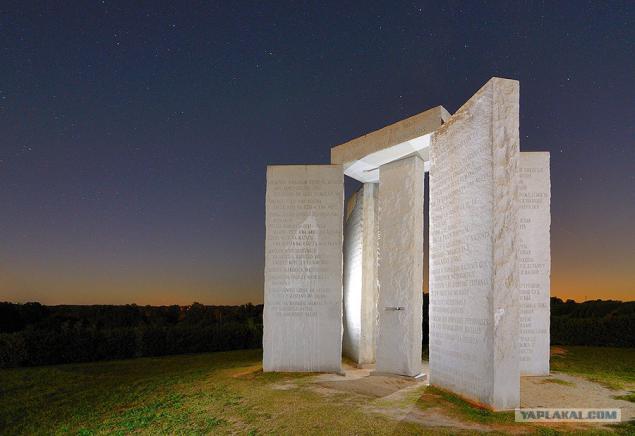
6. Nuraghe of Sardinia, Italy, Sardinia
Semi-conical structures resembling beehives huge (up to 20 m), appeared in Sardinia at the end of the II millennium BC, before the arrival of the Romans. The tower was built without a foundation of overlapping blocks of stone, not bonded to any solution and keep only due to its own weight. Appointment nuraghi unclear. Characteristically, the archaeologists have repeatedly found during excavations miniature models of these towers of bronze.
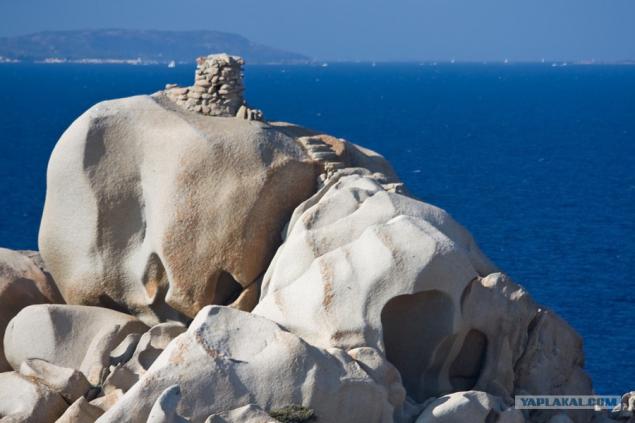
7. Saksauaman, Peru, Cuzco
Archaeological Park at an altitude of 3700 meters and an area of 3,000 hectares is located to the north of the capital of the Inca Empire. Defensive and simultaneously temple complex was built at the turn of the XV-XVI centuries. Zigzag battlements, reaching 400 meters in length and six in height, built of 200-ton stone blocks. As the Incas installed these blocks as they chased one under the other - unknown. On top Saksauaman looks like toothy head cougar Cusco (city was laid out in the form of the sacred animal of the Incas).
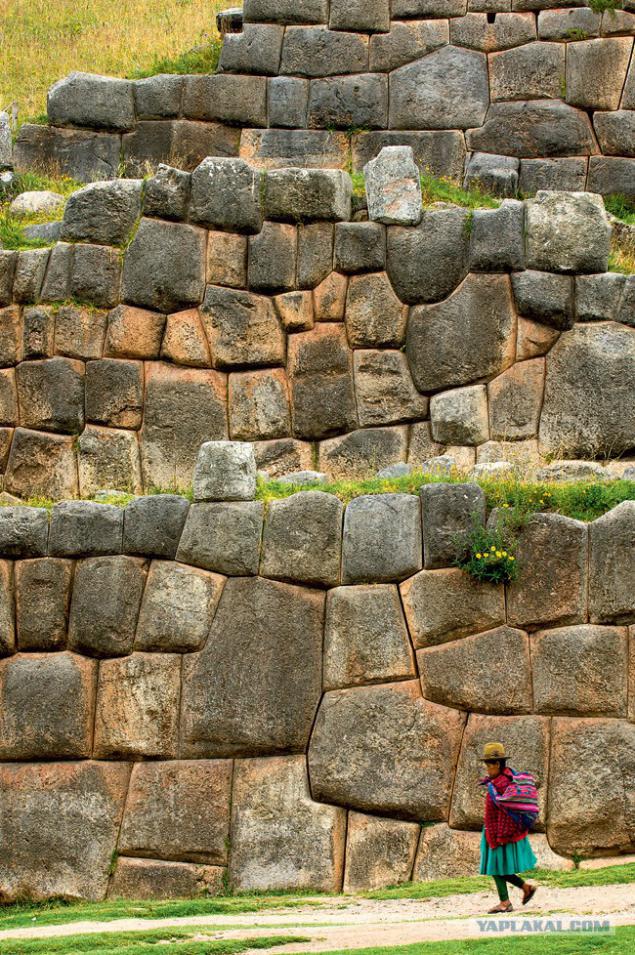
8. Stonehenge, United Kingdom, Salisbury
Altar, Observatory, Tomb, calendar? Scientists have not reached a consensus. Five thousand years ago, there were circular moat and ramparts around a diameter of 115 m. A few centuries later the ancient builders brought here 80 four-ton stones, and a couple of centuries - 30 megaliths weighing 25 tons. The stones were set in a circle and in the form of a horseshoe. The kind where Stonehenge survives today, largely the result of human activity recent centuries. People continued to work on the stones: the peasants otkolupyvali them to pieces, amulets, tourists were labeled territory inscriptions and restorers cooked the rest of the ancients, as here they that stood correctly.
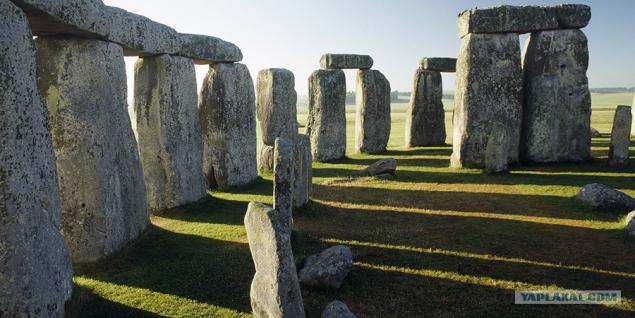
9. Newgrange, Ireland, Dublin
The Celts called it the mound fairies and felt the house of one of their main gods. Circular structure of stone, earth and gravel diameter of 85 meters, was built over 5,000 years ago. Inside the mound leads corridor ending the ritual chamber. During the winter solstice, this camera is brightly lit for 15-20 minutes a ray of sun that enters through the window over the entrance to the tunnel.
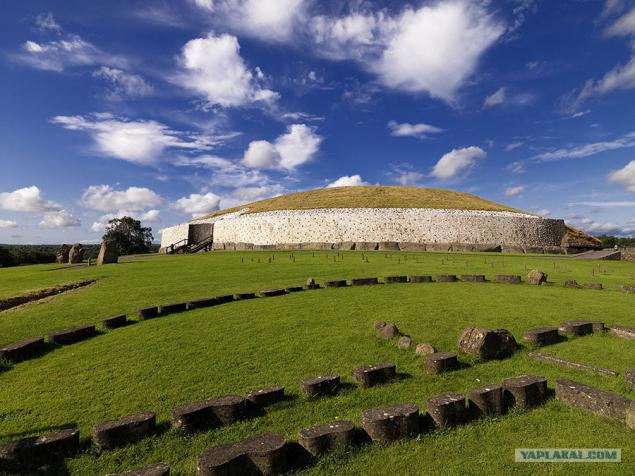
10. Coral Castle, United States, Florida, Homestead
Whimsical structure alone for 28 years (1923-1951) built a Latvian emigrant Edward Lindskalnin in honor of the lost love. The way a person of modest growth and body moves in space huge blocks, remains a mystery.
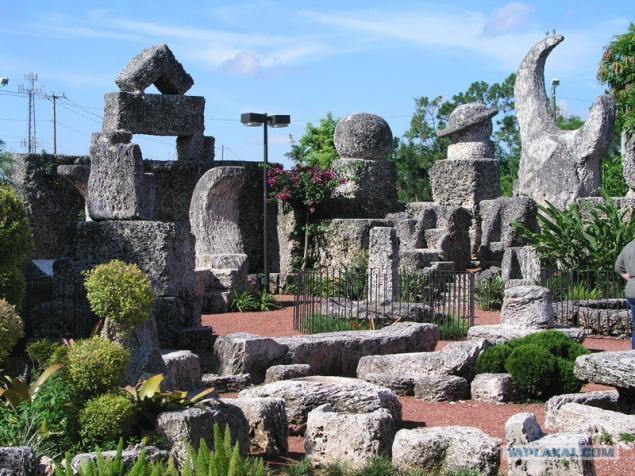
11. Statues "Reptilians", French Polynesia, island Nuku Hiva
Statues in a place called Temehea-Tohu in the Marquesas depict strange creatures whose appearance in the mass consciousness is associated with aliens. They are different: there is a big largemouth "reptilians", but there are others: with small torso and disproportionately large elongated head-helmet with huge eyes. They have in common one thing - evil facial expressions. Was it aliens from other worlds or just priests in disguise - is unknown. The statues date from about the beginning of II millennium.

12. Pyramid Ёnaguni, Japan, Ryukyu Archipelago
Monuments of huge stone pillars and platforms located at depths of 5 to 40 meters, were discovered in 1986. The most important of these structures has the form of a pyramid. Not far away is a large area with steps similar to the stadium with spectator stands. One object resembles a huge head like a Moai statues on Easter Island. In the scientific community there is debate, many believe that lying on the ocean floor formation are exclusively of natural origin. But singles like Masaaki Kimura, a professor of the University of the Ryukyus, repeatedly dive to the ruins, insist that there has not been without a man.
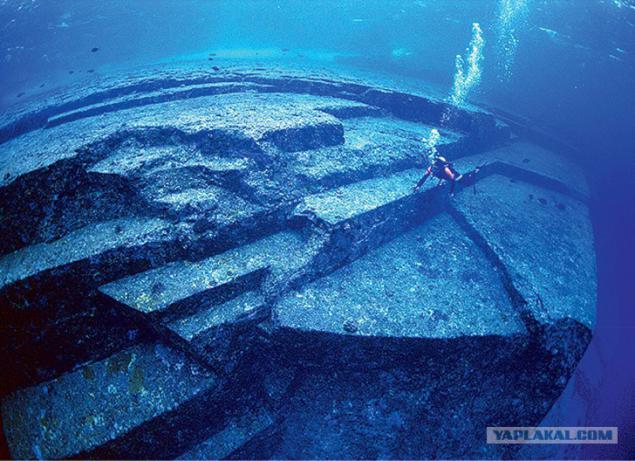
13. Goseck circle, Germany Goseck
The ring system of concentric ditches and wooden fences was created between 5000 and 4800 BCE Now renovated complex. Presumably, it was used as a solar calendar.
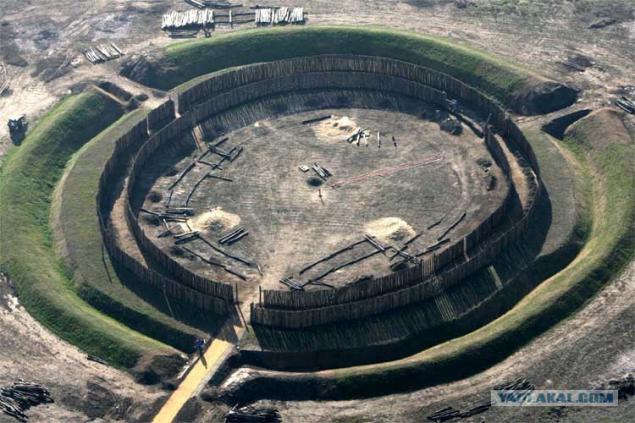
14. Great Zimbabwe, Zimbabwe, Masvingo
One of the largest and oldest stone structures in South Africa was built in the XI century, and in the XV for some unknown reason was abandoned. All designs (up to 11 meters in height and 250 in length) were built by drywall. Supposedly, in the settlement lived up to 18 000 people.
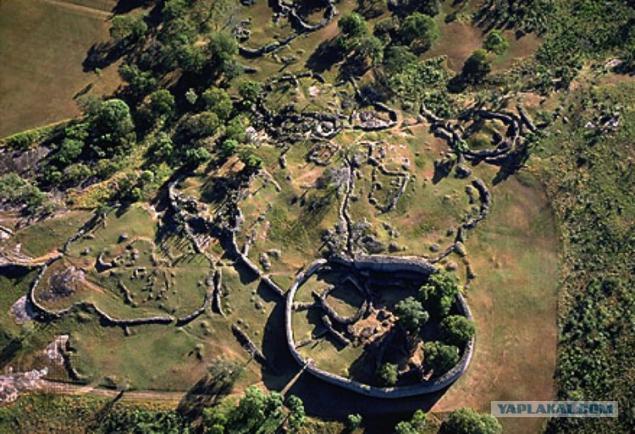
15. The Delhi pillar, India, New Delhi
Iron towers greater than 7 meters and weighing more than 6 tons - a part of the architectural complex of Qutab Minar. Was cast in honor of the king Chandragupta II in 415. For unclear reasons, column, almost 100% made of iron, is almost impossible to corrosion. Scientists try to explain this fact by different reasons: Special skill and techniques of ancient Indian blacksmiths, dry air and extreme weather conditions in the area of Delhi, forming a protective shell - in particular due to the fact that the Indians anoint sacred monument oils and spices. Ufologists, as usual, see the column next proof intervention of extraterrestrial intelligence. But the secret of "stainless steel" is still not solved.
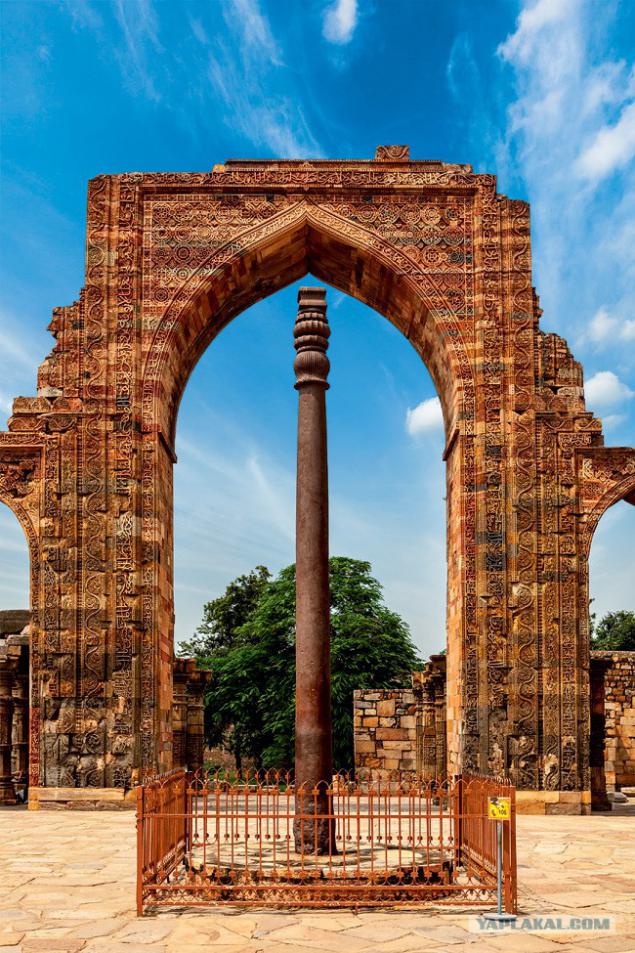
16. Lines of Nazca, Peru, Nazca
47-foot spider, hummingbird 93-meter, 134-meter eagle, lizard, alligator, snake, zoomorphic and other humanoids ... Giant picture aerial view seem devoid of vegetation scratched on the rock, and as if with one hand, in the same style . This is actually the furrow depth of 50 cm and a width of 135 cm, made at different times in the V-VII centuries.
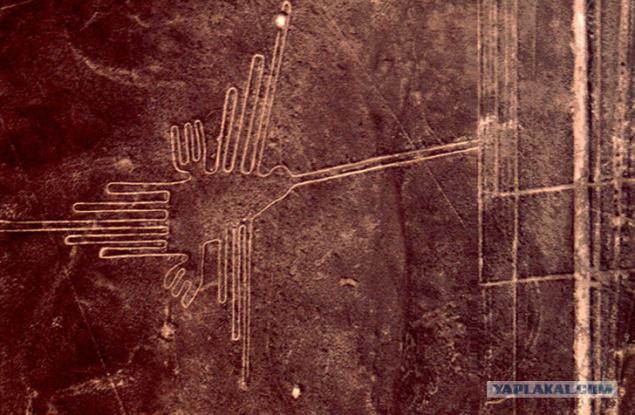
17. Observatory Nabta, Nubia, Sahara
In the sand beside the dry lake is the oldest arheoastronomichesky monument on the planet 1,000 years older than Stonehenge. Location megaliths allows to determine the day of the summer solstice. Archaeologists believe that people lived here seasonally, when the lake water was so needed in the calendar.
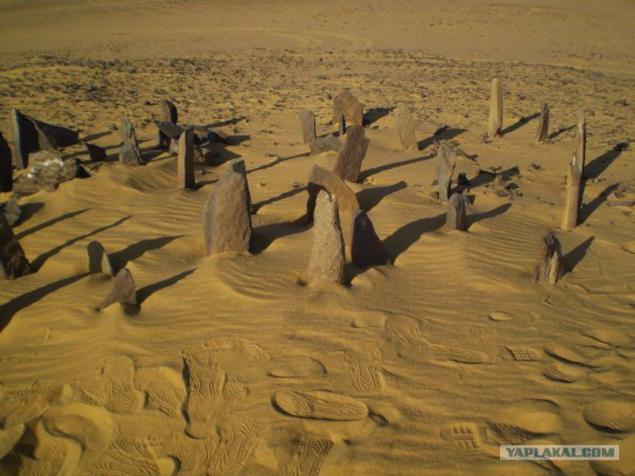
18. The Antikythera Mechanism, Greece, Antikifera
Mechanical device with dial, hands and gears in the early XX century were found on the wreck route from Rhodes (100 BC). After extensive research and reconstructions, scientists found that the unit served astronomical goals - allows you to monitor the movements of the heavenly bodies and to perform very complex calculations.
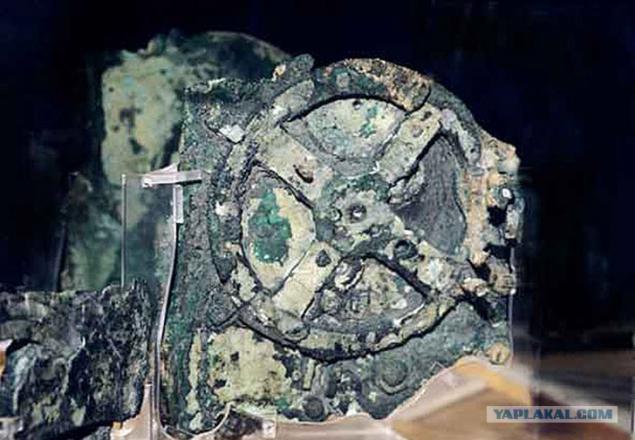
19. Plates Baalbek, Lebanon
The ruins of the Roman temple complex are I-II century AD But the Romans built a shrine for good reason. At the base of the temple of Jupiter are more ancient slabs weighing 300 tons. Western retaining wall is a series of "Trilithon" - three limestone blocks, each more than 19 meters long, 4 meters in height and weighing about 800 tons. Roman technique was unable to lift a weight. By the way, not far from the complex for thousands of years is still one unit - under 1,000 tons.
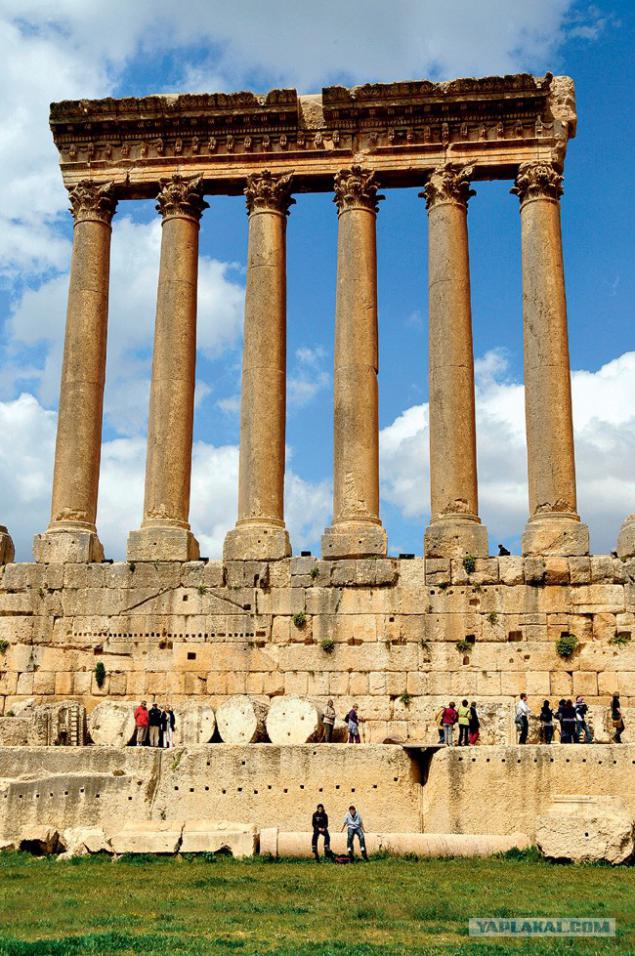
20. Gobekli Tepe, Turkey
Complex of the Armenian Highland is the oldest of the largest megalithic structures (approximately X-IX millennium BC). While people are still engaged in hunting and gathering, but someone was able to erect a huge following of stelae with images of animals.
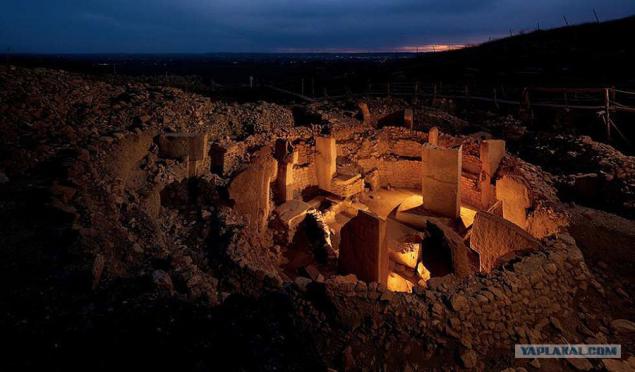
1. Arch, Russia, Chelyabinsk region
The settlement of the Bronze Age (III-II millennium BC) is on the same latitude as Stonehenge. Coincidence? Scientists do not know. Two rows of circular wall (diameter far - 170 m), the system of drains and sewerage, well in every house - a highly developed culture of evidence. The monument was discovered by students and pupils of the archaeological expedition in 1987. (In the photo - model-reconstruction.)

2. El Castillo, Chichen Itza, Mexico Chichen Itza
Each year during the spring and autumn equinox at the foot of the sanctuary of the supreme deity of the Maya - Feathered Serpent - gather thousands of tourists. They watch the miracle of "phenomena" Kukulcan serpent moves down along the balustrade of the main staircase. Creates the illusion of the game triangular shadows cast by nine platforms pyramid at the moment when the sun tending to decline, for 10 minutes highlights its northwest corner. Be the sanctuary shifted even a degree or anything like that would not happen

3. The Carnac Stones, France, Brittany, Carnac
In total, about 4,000 megaliths up to four meters apart slender alleys near the town of Carnac. The rows are parallel to each other or fan out, here and there form a circle. The complex dates back to the V-IV millennium BC In Brittany legends that this Merlin made petrify ranks of Roman legionaries.

4. Stone Balls, Costa Rica
Pre-Columbian artifacts, scattered near the Pacific coast of Costa Rica, were discovered in the 1930s, banana workers. Hoping to find gold inside, vandals destroyed a lot of balls. Now most of the remaining are kept in museums. The diameter of some stones reaches 2, 5 meters, weight - 15 tons. Purpose is unknown.

5. The Georgia Guidestones, United States, Georgia, Elbert
In 1979, one under the pseudonym RC Christian ordered the construction company manufacturing and installation of the monument - the construction of six granite monoliths weighing over 100 tons. On the four side plates engraved the Ten Commandments descendants in eight languages, including Russian. The last paragraph reads: "Do not be a cancer to the earth, nature, too, leave the place!»

6. Nuraghe of Sardinia, Italy, Sardinia
Semi-conical structures resembling beehives huge (up to 20 m), appeared in Sardinia at the end of the II millennium BC, before the arrival of the Romans. The tower was built without a foundation of overlapping blocks of stone, not bonded to any solution and keep only due to its own weight. Appointment nuraghi unclear. Characteristically, the archaeologists have repeatedly found during excavations miniature models of these towers of bronze.

7. Saksauaman, Peru, Cuzco
Archaeological Park at an altitude of 3700 meters and an area of 3,000 hectares is located to the north of the capital of the Inca Empire. Defensive and simultaneously temple complex was built at the turn of the XV-XVI centuries. Zigzag battlements, reaching 400 meters in length and six in height, built of 200-ton stone blocks. As the Incas installed these blocks as they chased one under the other - unknown. On top Saksauaman looks like toothy head cougar Cusco (city was laid out in the form of the sacred animal of the Incas).

8. Stonehenge, United Kingdom, Salisbury
Altar, Observatory, Tomb, calendar? Scientists have not reached a consensus. Five thousand years ago, there were circular moat and ramparts around a diameter of 115 m. A few centuries later the ancient builders brought here 80 four-ton stones, and a couple of centuries - 30 megaliths weighing 25 tons. The stones were set in a circle and in the form of a horseshoe. The kind where Stonehenge survives today, largely the result of human activity recent centuries. People continued to work on the stones: the peasants otkolupyvali them to pieces, amulets, tourists were labeled territory inscriptions and restorers cooked the rest of the ancients, as here they that stood correctly.

9. Newgrange, Ireland, Dublin
The Celts called it the mound fairies and felt the house of one of their main gods. Circular structure of stone, earth and gravel diameter of 85 meters, was built over 5,000 years ago. Inside the mound leads corridor ending the ritual chamber. During the winter solstice, this camera is brightly lit for 15-20 minutes a ray of sun that enters through the window over the entrance to the tunnel.

10. Coral Castle, United States, Florida, Homestead
Whimsical structure alone for 28 years (1923-1951) built a Latvian emigrant Edward Lindskalnin in honor of the lost love. The way a person of modest growth and body moves in space huge blocks, remains a mystery.

11. Statues "Reptilians", French Polynesia, island Nuku Hiva
Statues in a place called Temehea-Tohu in the Marquesas depict strange creatures whose appearance in the mass consciousness is associated with aliens. They are different: there is a big largemouth "reptilians", but there are others: with small torso and disproportionately large elongated head-helmet with huge eyes. They have in common one thing - evil facial expressions. Was it aliens from other worlds or just priests in disguise - is unknown. The statues date from about the beginning of II millennium.

12. Pyramid Ёnaguni, Japan, Ryukyu Archipelago
Monuments of huge stone pillars and platforms located at depths of 5 to 40 meters, were discovered in 1986. The most important of these structures has the form of a pyramid. Not far away is a large area with steps similar to the stadium with spectator stands. One object resembles a huge head like a Moai statues on Easter Island. In the scientific community there is debate, many believe that lying on the ocean floor formation are exclusively of natural origin. But singles like Masaaki Kimura, a professor of the University of the Ryukyus, repeatedly dive to the ruins, insist that there has not been without a man.

13. Goseck circle, Germany Goseck
The ring system of concentric ditches and wooden fences was created between 5000 and 4800 BCE Now renovated complex. Presumably, it was used as a solar calendar.

14. Great Zimbabwe, Zimbabwe, Masvingo
One of the largest and oldest stone structures in South Africa was built in the XI century, and in the XV for some unknown reason was abandoned. All designs (up to 11 meters in height and 250 in length) were built by drywall. Supposedly, in the settlement lived up to 18 000 people.

15. The Delhi pillar, India, New Delhi
Iron towers greater than 7 meters and weighing more than 6 tons - a part of the architectural complex of Qutab Minar. Was cast in honor of the king Chandragupta II in 415. For unclear reasons, column, almost 100% made of iron, is almost impossible to corrosion. Scientists try to explain this fact by different reasons: Special skill and techniques of ancient Indian blacksmiths, dry air and extreme weather conditions in the area of Delhi, forming a protective shell - in particular due to the fact that the Indians anoint sacred monument oils and spices. Ufologists, as usual, see the column next proof intervention of extraterrestrial intelligence. But the secret of "stainless steel" is still not solved.

16. Lines of Nazca, Peru, Nazca
47-foot spider, hummingbird 93-meter, 134-meter eagle, lizard, alligator, snake, zoomorphic and other humanoids ... Giant picture aerial view seem devoid of vegetation scratched on the rock, and as if with one hand, in the same style . This is actually the furrow depth of 50 cm and a width of 135 cm, made at different times in the V-VII centuries.

17. Observatory Nabta, Nubia, Sahara
In the sand beside the dry lake is the oldest arheoastronomichesky monument on the planet 1,000 years older than Stonehenge. Location megaliths allows to determine the day of the summer solstice. Archaeologists believe that people lived here seasonally, when the lake water was so needed in the calendar.

18. The Antikythera Mechanism, Greece, Antikifera
Mechanical device with dial, hands and gears in the early XX century were found on the wreck route from Rhodes (100 BC). After extensive research and reconstructions, scientists found that the unit served astronomical goals - allows you to monitor the movements of the heavenly bodies and to perform very complex calculations.

19. Plates Baalbek, Lebanon
The ruins of the Roman temple complex are I-II century AD But the Romans built a shrine for good reason. At the base of the temple of Jupiter are more ancient slabs weighing 300 tons. Western retaining wall is a series of "Trilithon" - three limestone blocks, each more than 19 meters long, 4 meters in height and weighing about 800 tons. Roman technique was unable to lift a weight. By the way, not far from the complex for thousands of years is still one unit - under 1,000 tons.

20. Gobekli Tepe, Turkey
Complex of the Armenian Highland is the oldest of the largest megalithic structures (approximately X-IX millennium BC). While people are still engaged in hunting and gathering, but someone was able to erect a huge following of stelae with images of animals.









